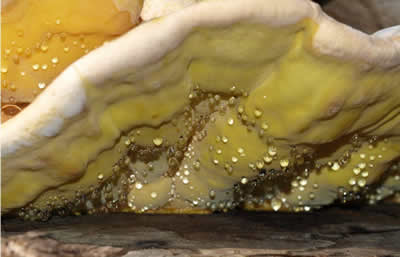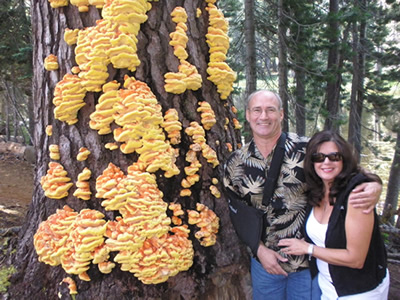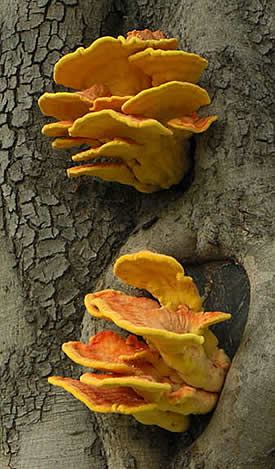Western Sulphur Shelf Species: Laetiporus gilbertsonii and conifericola

Laetiporus gilbertsonii, on a eucalyptus stump. © photo by Debbie Viess
Laetiporus gilbertsonii, our local species of Sulphur Shelf or Chicken of the Woods, is a parasite on hardwoods — mainly oaks and eucalyptus. Its fruiting bodies can be found on stumps or on the trunk or base of the living tree. When young, the spongy shelves are pale salmon orange or pale pinkish orange. The flesh is pale yellow to nearly white. The pore surface is lemon-yellow to pale lemon-yellow. As the fungus matures, the shelves can turn tan to light brown, and the consistency gets more woody. Mushroomers usually collect the soft margins of the young fruiting body, as this part is more likely to be palatable. Sulphur shelves often fruit early in the season and can appear on freshly cut stumps any time of year, and can return year after year when conditions are good. L. gilbertsonii is reported from the Mexican border along the Pacific Coast as far north as the state of Washington.

Laetiporus conifericola, at Donner Summit, CA. © photo by Hugh Smith
The West Coast has a second Sulphur Shelf species, Laetiporus conifericola, which occurs on mature and dead conifers in western North America from California to the Kenai Peninsula in Alaska. The young shelves are bright orange to salmon orange, the flesh is pale yellow, and the pore surface is lemon yellow to bright creamy yellow. It is not considered as “palatable” as L. gilbertsonii, because it may have a sour taste.
Fungi in the genus Laetiporus are parasitic — they cause brown rot in the butt or roots of the tree, on heartwood in living trees. They also fruit on dead trees and downed logs and stumps. There are eight species in the United States. Our western species, L. gilberstonii and L. conifericola, can form huge fruiting bodies weighing 30 lbs. or more. They form shelves in one or multiple locations on the same tree.
Sulphur shelves may cause gastrointestinal problems, as one of our BAMS contributors recently experienced:

Laetiporus gilbertsonii © photo by Jason Hollinger
I've had several Sulphur Shelf sightings around Chico in the past week or so, but they were either too old, too high up, or cleaned out by the time I got back there with my bag — so I was delighted to spy a lot of very fresh new soft clumps on a big old dead oak snag in Lower Bidwell Park. Took a bunch and left a lot more for good karma. Then I found another batch on a living valley oak and took a more formed, mature but still soft shelf to give my friends. My son and I sauteed a few slices for lunch in butter — about five each, all together about the size of an orange. They were delicious, albeit rather dry because I wanted to cook them thoroughly. No ill effects. At dinner I sauteed a couple of clumps, together about the size of a large acorn squash. My husband, son, and I ate them with salad, bread, and sausage, with a white wine-garlic-butter sauce.
I ate the most (although I may have embellished a bit if it sounded really gluttonous — it was a pretty light dinner). My husband and I drank a glass or two of wine as well. Our daughter ate the other shelf from the other tree with our friends who live nearby. None of them got ill, and neither did my son. I am physically the smallest in our family, but I ate the most mushrooms, so I got pretty queasy after about an hour and vomited pretty painfully after about three hours. My husband felt queasy until midday Saturday (having puked I felt better sooner). Daughter, son, and friends were just fine — maybe the big difference was that my husband and I drank wine.
—contributed by Alicia Springer
Obviously, caution is urged for eating any Sulphur Shelf. Cooking time may be a factor, and some feel that Laetiporus growing on eucalyptus trees may contribute to digestive upsets, but both western species have been implicated.
When Dr. Tom Volk, University of Wisconsin-La Crosse, talks to groups about Laetiporus mushrooms, he asks whether people have eaten them and if they were enjoyed. If he’s lecturing on the East Coast, many hands go up with positive feedback. On the West Coast, for our two species, he sees far fewer hands. Volk says the common name, chicken of the woods, comes from its "remarkable resemblance to chicken meat when cooked properly." In 2001, Hal Burdsall and Mark Banik published a paper, The genus Laetiporus in North America1, which described three new species and one variety. For the first time, our western species were clearly delineated. The mushroom we had been calling Laetiporus suphureus, was now broken taxonomically into two species: L. gilbertsonii and L. conifericola.
© David Rust
1Burdsall, H. H. Jr. & Banik, M. T. (2001). The genus Laetiporus in North America. Harvard Papers in Botany 6: 43-55.

 back to top
back to top